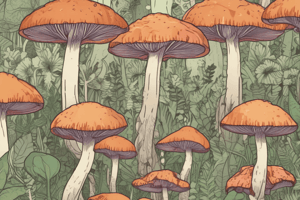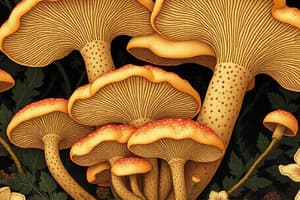Podcast
Questions and Answers
What is the function of vegetative hyphae?
What is the function of vegetative hyphae?
- To form symbiotic associations with other organisms
- To absorb and distribute nutrients to other parts for growth and development (correct)
- To produce asexual spores
- To project above the surface in culture medium
What is the term for obtaining nutrients from another living organism?
What is the term for obtaining nutrients from another living organism?
- Vegetative growth
- Saprophytism
- Symbiotic associations
- Parasitism (correct)
What is the term for the process of absorbing nutrients from dead organic matter?
What is the term for the process of absorbing nutrients from dead organic matter?
- Symbiotic associations
- Vegetative growth
- Parasitism
- Saprophytism (correct)
What is the term for the association between fungi and the roots of higher plants?
What is the term for the association between fungi and the roots of higher plants?
What is the term for the outgrowth that develops from a spore during asexual reproduction?
What is the term for the outgrowth that develops from a spore during asexual reproduction?
How do fungi reproduce?
How do fungi reproduce?
What is the habitat of fungi?
What is the habitat of fungi?
What is the term for the extensive network of hyphae produced during asexual reproduction?
What is the term for the extensive network of hyphae produced during asexual reproduction?
Where were fungi originally classified?
Where were fungi originally classified?
What is characteristic of some animal cells that is also found in fungi?
What is characteristic of some animal cells that is also found in fungi?
What is generally absent from the cell walls of true fungi?
What is generally absent from the cell walls of true fungi?
What is the characteristic of moulds that is different from yeasts?
What is the characteristic of moulds that is different from yeasts?
What is the term used to describe the entangled mass of hyphae?
What is the term used to describe the entangled mass of hyphae?
What is the characteristic of aseptate hyphae?
What is the characteristic of aseptate hyphae?
What is the function of septa in septate hyphae?
What is the function of septa in septate hyphae?
How does cytoplasm flow through the hyphae?
How does cytoplasm flow through the hyphae?
What is the source of the antibiotic drug Penicillin?
What is the source of the antibiotic drug Penicillin?
Which fungus is used to control nematodes in the soil?
Which fungus is used to control nematodes in the soil?
What is the name of the fungus that causes the Late blight of potato?
What is the name of the fungus that causes the Late blight of potato?
Which of the following is an example of a human fungal infection?
Which of the following is an example of a human fungal infection?
What is the name of the fungus that parasitises insects?
What is the name of the fungus that parasitises insects?
Which of the following is an example of a food that can be spoiled by fungi?
Which of the following is an example of a food that can be spoiled by fungi?
Which fungus causes rotting of wood?
Which fungus causes rotting of wood?
Which of the following is an example of a crop disease caused by fungi?
Which of the following is an example of a crop disease caused by fungi?
What is the result of the fusion of haploid nuclei of compatible hyphae during sexual life cycle?
What is the result of the fusion of haploid nuclei of compatible hyphae during sexual life cycle?
Where is the basidium located in a mushroom?
Where is the basidium located in a mushroom?
What is the characteristic feature of Chytridiomycota?
What is the characteristic feature of Chytridiomycota?
What is the primary role of fungi in the ecosystem?
What is the primary role of fungi in the ecosystem?
Which type of fungi is known for its symbiotic association with plant roots?
Which type of fungi is known for its symbiotic association with plant roots?
Which group of fungi is characterized by the production of non-motile spores?
Which group of fungi is characterized by the production of non-motile spores?
What is the term for the association between fungi and plant roots?
What is the term for the association between fungi and plant roots?
What is the characteristic feature of Ascomycota?
What is the characteristic feature of Ascomycota?
What is the common name for Rhizopus and Mucor species?
What is the common name for Rhizopus and Mucor species?
Which of the following is an example of an edible mushroom?
Which of the following is an example of an edible mushroom?
What is the role of fungi in the food industry?
What is the role of fungi in the food industry?
Which group of fungi includes yeasts, food spoilage moulds, and morels?
Which group of fungi includes yeasts, food spoilage moulds, and morels?
What is the characteristic feature of Basidiomycota?
What is the characteristic feature of Basidiomycota?
What is a unique characteristic of Truffle mushrooms?
What is a unique characteristic of Truffle mushrooms?
What is the economic importance of fungi in agriculture?
What is the economic importance of fungi in agriculture?
What is the typical state of fungal cells during most of their life cycle?
What is the typical state of fungal cells during most of their life cycle?
Flashcards are hidden until you start studying
Study Notes
Fungal Diversity
- Fungi were originally classified with photosynthetic plants, but later separated and grouped with algae and protozoa (protista) and then placed in the Kingdom Mycota.
- Fungi lack chlorophyll and their cell walls contain chitin, mannan, and β-glucans, which are characteristics of some animal cells.
- Cellulose is generally absent from the cell walls of true fungi.
Structural Forms
- Fungi can exist as unicellular or multicellular forms with several different cell types.
- Multicellular fungi are primarily filamentous in their growth form, with long, slender filaments called hyphae that form an entangled mass called mycelium.
Morphological Features of Hyphae
- Hyphae are of two types: aseptate (non-septate or coenocytic) and septate.
- Aseptate hyphae are continuous or branching filaments filled with cytoplasm and multiple nuclei.
- Septate hyphae are made up of long chains of cells joined end-to-end and divided by cross-walls called septa, which have pores.
Hyphae Classification Based on Function
- Vegetative hyphae: grow as submerged or surface filaments, digesting, absorbing, and distributing nutrients obtained from the substrate to other parts for growth and development.
- Aerial hyphae: project above the surface in culture medium.
- Reproductive/fertile hyphae: aerial hyphae that produce asexual spores on the surface of the substrate.
Nutrition
- Fungi acquire nutrients by three means: parasitism, saprophytism, and symbiotic associations.
- Parasitism: obtaining nutrients from another living organism (e.g., Phytophthora sp. being parasitic on cocoa plants).
- Saprophytism: absorbing nutrients from dead organic matter (e.g., Termitomyces sp. feeding on litter).
- Symbiotic associations: exchanging nutrients with other organisms, especially roots of higher plants (e.g., Boletus spp. and Glomus spp. associating with roots to form mycorrhizae).
Habitat
- Fungi occur both on land (terrestrial) and in water (aquatic - freshwater and marine).
Reproduction
- Fungi reproduce in three ways: sexual, asexual, and vegetative (budding, as seen in yeast).
- Both sexual and asexual reproduction occur in fungi.
Life Cycle
- During the asexual life cycle, spores settle on a substrate, develop an outgrowth known as a germ tube, which then elongates into a hypha.
- During the sexual life cycle, the haploid nuclei of compatible hyphae fuse, forming a diploid nucleus (zygote), which subsequently participates in sexual spore development through meiosis.
Fungal Classification
- The four major groups are: Chytridiomycota, Zygomycota, Ascomycota, and Basidiomycota.
- Chytridiomycota: characterized by motile spores (zoospores) and commonly called chytrids.
- Zygomycota: characterized by the production of non-motile spores, with a coenocytic mycelial organization.
- Ascomycota: characterized by the production of sexually produced spores (ascospores) contained within a sac called an ascus.
- Basidiomycota: characterized by the production of basidiospores in a structure called a basidium.
Economic Importance of Fungi
- Recycling of nutrients/maintenance of soil fertility: fungi decompose dead organic material, releasing nutrients back into the ecosystem.
- Formation of symbiotic associations with plant roots: fungi provide the host with water, nutrients, and pathogen protection, in exchange for photosynthetic products.
- Food: fungi are consumed directly or used indirectly in the food and beverage industry.
- Medicines: fungi produce antibiotics that are widely used medicinally to control diseases.
- Biocontrol of soil-borne pathogens: fungi are used to control pests, such as nematodes and insects.
- Crop diseases: fungi cause the majority of known plant diseases, resulting in significant economic losses.
- Animal diseases: fungi can parasitize domestic animals, causing diseases, but this is not usually a major economic problem.
- Spoilage of food and goods: fungi cause spoilage of food and other consumable goods, such as fabric, leather, and paper.
Studying That Suits You
Use AI to generate personalized quizzes and flashcards to suit your learning preferences.




